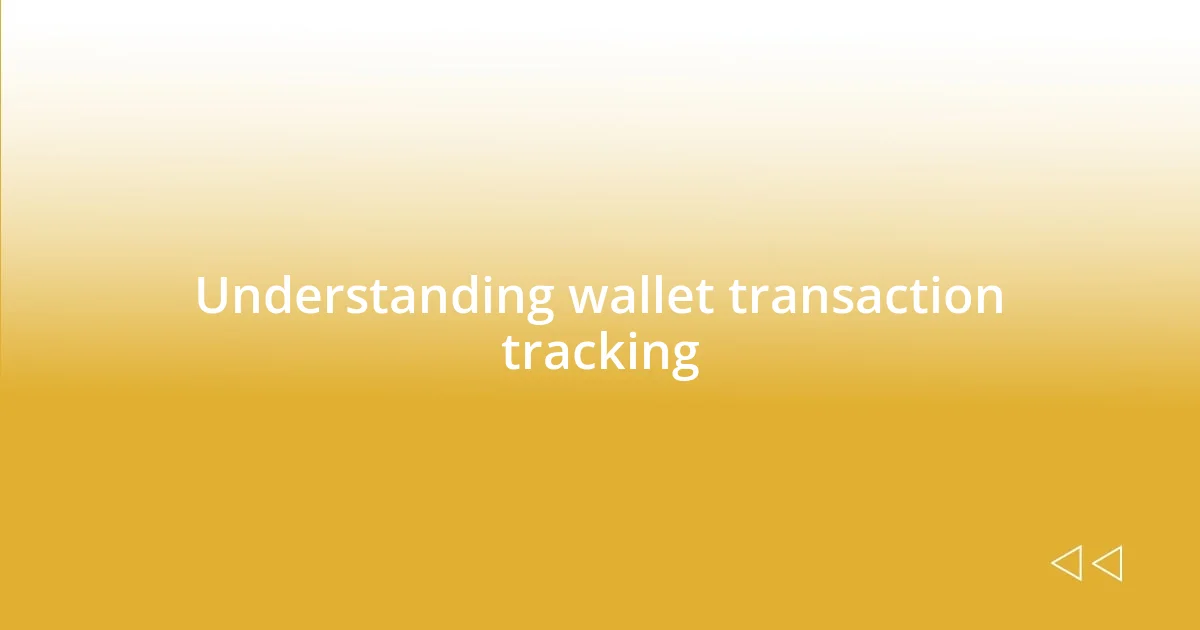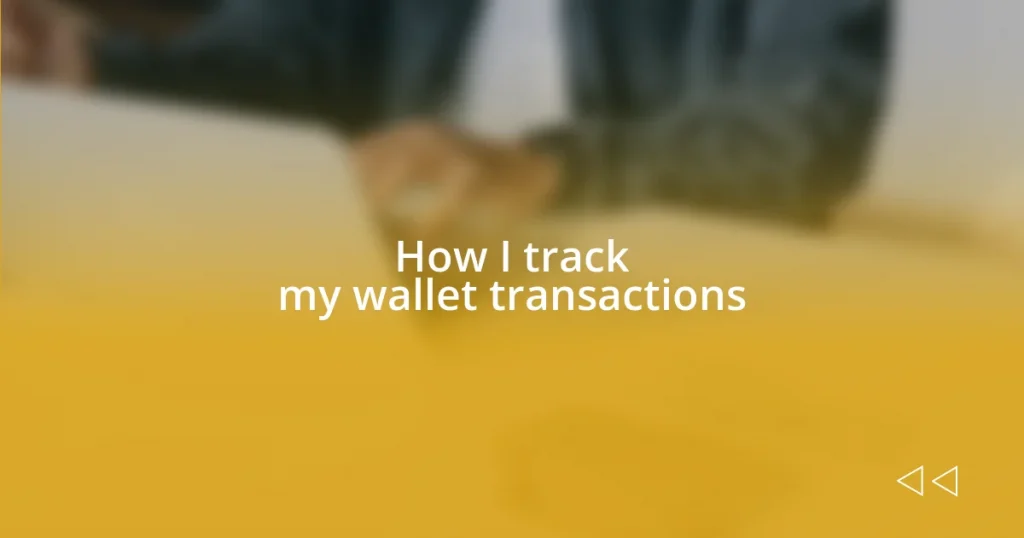Key takeaways:
- Understanding wallet transaction tracking helps gain control over finances and reveals spending patterns.
- Selecting a user-friendly wallet app with features like categorization and budgeting tools simplifies financial management.
- Ensuring security through encrypted apps and two-factor authentication is essential for safe transaction tracking.

Understanding wallet transaction tracking
Understanding wallet transaction tracking isn’t just a technical endeavor; it’s about gaining insight into your financial habits. I remember the first time I reviewed my transactions—seeing those little charges add up was eye-opening. Have you ever wondered where all your money goes?
The process can be somewhat daunting at first, especially with the plethora of wallet apps available. Yet, once I started categorizing my spending, it became clearer to me what I prioritized—be it entertainment, groceries, or unexpected expenses. It’s fascinating how tracking can often reveal patterns or habits that we might overlook in the hustle and bustle of daily life.
Moreover, tracking transactions isn’t solely about budgeting; it’s also about peace of mind. When I first embraced wallet transaction tracking, I felt an incredible sense of control over my finances. Knowing where my money was going empowered me. Have you experienced that same relief in tracking your spending?

Choosing the right wallet app
Choosing the right wallet app can genuinely transform how you manage your finances. I’ll never forget the moment I found an app that aligned perfectly with my needs; it felt like discovering a hidden gem. It wasn’t just about the features; it was how intuitive the interface was, making my tracking effortless and even enjoyable.
Here are some key features to consider when selecting a wallet app:
- User-Friendly Interface: An app should be easy to navigate, even for those who aren’t tech-savvy.
- Robust Security: Look for apps that offer strong encryption and two-factor authentication to protect your data.
- Multi-Currency Support: If you deal with different currencies, ensure the app can handle that smoothly.
- Categorization Options: A feature that lets you categorize transactions simplifies budgeting and provides insight into spending habits.
- Budgeting Tools: Some apps come with built-in budgeting tools that can help you set and review financial goals.
When I first switched to an app with well-organized categories, I found it so much simpler to identify where I could cut back. I realized how many little splurges I had been ignoring. That knowledge empowered me to make informed decisions, and it was liberating to feel in control of my financial journey.

Setting up transaction notifications
Setting up transaction notifications has been a game-changer for me. At first, I felt overwhelmed with the sheer volume of transactions flowing through my wallet, but once I enabled notifications, the clarity they provided was invaluable. Have you ever received an alert moments after making a purchase? It not only confirmed the transaction but also gave me a sense of being in the driver’s seat of my finances.
I remember when I set up my first transaction notification—it was surprisingly easy. Most wallet apps allow you to customize alerts based on different triggers, like spending limits or category changes. By fine-tuning these settings, I could prioritize what mattered most, ensuring I was alerted when I overspent on dining or received any unexpected charges. The immediate feedback helped me adjust my spending behavior almost in real-time.
One feature that I found particularly helpful was the option to receive summary notifications at the end of the day or week. Initially, I was unsure how useful they would be, but seeing my spending trends summarized helped me identify patterns I wanted to change. Those little nudges throughout my financial journey made a huge difference. It’s like having a financial buddy reminding you of your goals without being overbearing.
| Feature | Description |
|---|---|
| Instant Alerts | Notifies you immediately after a transaction occurs. |
| Customized Settings | Allows you to specify triggers for notifications, such as spending thresholds or specific categories. |
| Daily/Weekly Summaries | Sends a summary of transactions over a specified period to reflect on spending habits. |

Categorizing your transactions
When it comes to categorizing your transactions, I’ve found that defining clear categories is essential for gaining real financial insights. I remember the first time I assigned categories like “Groceries,” “Entertainment,” and “Transportation” to my spending. It was eye-opening to see how much I was actually spending on takeout compared to cooking at home. I started to ask myself: Am I really getting value for that money, or is it just convenience?
One practical tip is to review and adjust your categories periodically. Your spending habits might change over time, and so should your categories. For instance, during summer, my entertainment expenses spiked with outdoor activities. This shift prompted me to create a summer budget category for those months, allowing me to track my spending dynamically. It felt empowering to adapt my financial strategy based on my life changes.
Additionally, consider using color-coding or tags to make the categorization process more visually appealing and intuitive. I often use a color for “Essentials” like utilities that remind me of necessary expenses, while vibrant hues for “Fun” expenditures feel more celebratory. This small tweak made my tracking system not only efficient but also enjoyable, blending practicality with a bit of creativity. How does your tracking system look? Maybe a little visual flair could add to your financial journey, too!

Analyzing spending patterns
Analyzing spending patterns can reveal fascinating insights about my financial behavior. I recall the first time I aggregated my transactions; I was shocked to discover that my coffee runs were adding up to a substantial amount each month. I asked myself, “Was that caffeine kick worth the price tag?” It was a pivotal moment that prompted me to reassess my daily choices, ultimately leading to a healthier budget.
Diving deeper into my spending data, I noticed certain triggers impacting my habits. For instance, I found that my impulse buys often spiked during stress-filled weeks. This revelation encouraged me to explore healthier alternatives, like taking a walk or practicing mindfulness when I felt the urge to splurge. It’s amazing how understanding the context of my spending could foster not just better financial decisions, but also enhance my overall well-being.
Furthermore, tracking my spending patterns over time has allowed me to plan more effectively for future expenses. I remember preparing for a vacation; analyzing my previous months’ expenditures helped me to set a realistic budget. By knowing my usual spending trends, I became more confident in allocating just the right amount for travel, allowing me to enjoy my trip without the stress of overspending. Have you found that analyzing your transactions has changed how you view your financial landscape?

Using spreadsheets for records
Using spreadsheets for tracking wallet transactions has truly transformed my financial management. Initially, I was overwhelmed by the idea of maintaining a spreadsheet, but I took the plunge and found it surprisingly straightforward. I set up columns for dates, amounts, categories, and even notes, which helped me become more mindful of every transaction I made. Wouldn’t it be liberating to see your entire financial picture laid out clearly?
As I became more comfortable with spreadsheets, I started utilizing formulas to automate calculations. For example, I created a summary row that automatically totaled my monthly spending by category. This small enhancement made a huge difference; seeing the numbers change in real-time when I input new transactions added a layer of motivation. I couldn’t help but feel a sense of accomplishment each month when I watched my savings grow while keeping my expenses in check.
Another powerful feature I discovered was the ability to create charts. Visualizing my cash flow helped me identify trends I hadn’t noticed before. One month, I realized my dining out expenses were rising faster than anticipated. I paused and thought, “Is this really worth it?” That moment led me to cook at home more often, which not only saved me money but brought joy to my evenings. Have you tried incorporating tools like spreadsheets into your tracking system? You might be amazed at how engaging and revealing the experience can be!

Ensuring security in transaction tracking
Ensuring security while tracking transactions is something I prioritize deeply. I remember the initial anxiety I felt about sharing my financial data, especially online. It led me to explore secure methods, such as using encrypted apps and keeping my spreadsheets password-protected. Have you ever felt that nervous flutter when considering where to store your details? Taking those proactive steps really calmed my worries.
When I reflect on my transaction tracking experience, I can’t help but emphasize the importance of two-factor authentication. This feature has become an essential tool in my financial arsenal. I vividly recall a moment when I nearly panicked after receiving an alert about a login attempt from an unfamiliar location. Thankfully, with two-factor authentication in place, I quickly secured my account before any harm could be done. It’s incredible how a simple layer of security can bring peace of mind.
Beyond tools, it’s also about cultivating a habit of vigilance. I started regularly reviewing my accounts to catch any discrepancies. There was a time when an unfamiliar charge slipped through, and I recall the sense of unease that washed over me. However, spotting it promptly allowed me to report it quickly, preventing further issues. What moment made you realize the necessity of being vigilant in your transaction tracking? I’ve learned that staying engaged with my finances not only protects my assets but also empowers my financial journey.















